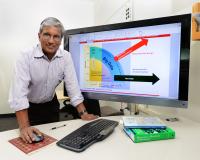A new approach to harnessing data in materials science computing has been developed by Krishna Rajan, Wilkinson Professor of Interdisciplinary Engineering at Iowa State University and Director of the University’s International Combinatorial Sciences and Materials Informatics Collaboratory and Institute for Combinatorial Discovery.
 Professor Krishna Rajan of Iowa State University (Credit: Bob Elbert/Iowa State University)
Professor Krishna Rajan of Iowa State University (Credit: Bob Elbert/Iowa State University)
Rajan believes that the key to employing computation devices to facilitate new material discovery lies in exploiting the four characteristics of data, namely, veracity, volume, velocity and variety. Rajan, who is also an Ames Laboratory associate, considers knowledge to be more important than data and wants the focus of material science computing to shift from volume.
The statistical learning methods developed by Rajan and his team have helped in the research and development of many new materials. Examples of these are the pathogen mimicking vaccine delivery materials and materials demonstrating enhanced piezoelectric effects; all of which were developed at Iowa State University by adopting the computing technique conceived by Rajan and his team. Rajan compares the computational process to the process employed in cooking spaghetti sauce. His premise is that instead of starting the sauce by using every available ingredient at the store, the sauce preparation should begin with the important ingredients which are tomatoes and salt. The quantity of the core ingredients can be varied to get different results. Similarly, in materials science research, the first step is to identify the important design rules for the material to be developed and on that basis, use computing tools to sift through compound libraries for the best solution. Rajan’s technique has its premise in statistical concepts, information theory and data mining.